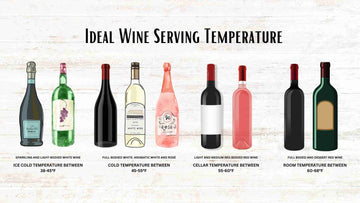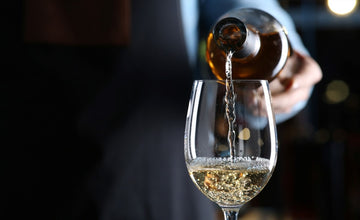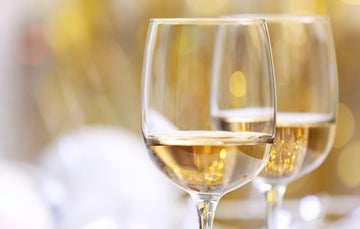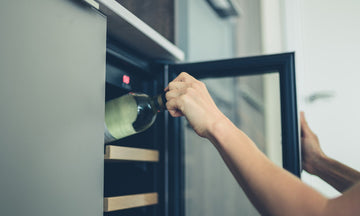Best way to store wine: Tips for storing wine in top condition!
by Jeremy Black on Jan 04, 2023

When it comes to properly preserving and storing your wine, there are a few important tips to keep in mind. This is especially true if you plan on aging your wines for long periods of time.
First, make sure that the temperature of the storage area is consistent. Too much fluctuation can affect the flavor and character of the wine. Generally speaking, most wines should be stored at temperatures around 55-58 degrees Fahrenheit.
Second, store your bottles of wine horizontally instead of vertically as this will keep the cork moist and help prevent air from entering into the bottle. Corks that dry out can crack or shrink which leads to oxidation in the bottle - not something any wine lover wants!
Finally, store your wines away from light, vibration and extreme temperatures. Light can cause the wine to lose its color and flavor, while vibrations can have an effect on the sediment in the wine. Extreme temperatures can damage corks or even cause bottles to burst.
By following these simple tips, you can be sure that you are storing your wines in top condition! For more information about proper storage of wines, check out our blog for to know more!

Wine Storage Temperature | How to Store Red and White Wine?
Nearly all wine experts agree wine storage temperature compared to wines served temperature is not the same. White wine is served with an average serving temperature of - In addition, the serving temperatures differ between two different white and red types. It seems easier to store wines in a cooler room. This will be easy for even a refrigerated wine storage cabinet or wine storage accessories. Keep an eye on the wine tracks for your collection. Tell us how the temperature difference of wines stored in storage and served will differ. Also discussed will be the optimal storage temperature for primary types of wine.

The best wine storage temperature (wine storage temperature chart)
Wine stores have become an important factor in attracting wine fanatics. The optimal wine storage temperature is also required for preservation of the value of the first sip. Stored wine should be stored properly so that your taste and the flavor do not change. How should I know what temperature to keep varying wines in storage should be regulated? You can learn more about temperature for storage of wine from our blog.

What temperature should I store my wine?
As stated previously, storing the right temperature in your bottle varies depending on which wine you're buying. Fortunately, the rules for wine storage are quite simple, so you can see how long the wines are stored. Just as the wine you want served at room temperature should also be cold, white and rosé wines should be kept in a cooler place compared to red wines. A general rule is that lighter a bottle, the colder. Darker reds are best stored at cooler temperatures than rosés, whites and sparkling wines, whereas optimal temperatures decrease with the wine becoming lighter.

Why is storage temperature important anyway?
- Temperature is a crucial factor for storage of wine. A proper wine temperature can keep your wines in great condition, prevent them from being too warm or cold (which can damage them severely), preserving overall wine quality. The optimal temperature for storing a wine varies according to the wine type, and the temperature ranges between freezing temperatures and less than freezing. Changing the temperature of your wine can be incredibly beneficial in the long term.

Temperature consistency.
Keep things constant at all times with the wine preserving process. Temperature fluctuations are very detrimental to wine. Temperatures above 69 degrees age the wine faster, causing negative effects on the wine taste. Using temperatures too cold can cause damage to cork. Wine experts cite consistency as ten fundamental elements that should be considered during the wine storage process. This can affect your wines taste and temperature.

Red wine storage temperature
55° C are ideal temperatures for wine storage. This is not an exact recommendation as temperatures can vary between 1 and 2 degrees and remain the perfect wine storage temperature. Temperatures are consistent.

White wine storage temperature
55°F is optimal for white wine storage. It's also possible some degrees above the surface will help keep things safe. As long as storage conditions stay constant. Is that really so easy? It's definitely possible! Depending on what wines benefit most in 53-54 degrees and 56-57 degrees, the difference in storage will not be noticeable. Wines are stored successfully if they are stored properly and provide the stability and non-destructive environments to protect the wine from extreme temperatures. Those degree levels are not particularly important to me.

Frequently Asked Questions:
Is it better to keep wine in the fridge or room temperature?
When it comes to fine wines, the ideal wine storage temperature is 55°F (13°C). This temperature slows down the aging process and allows you to enjoy your wine at its peak. However, refrigeration can cause off flavors in wines due to a rapid decrease in temperature. This means that if you are storing wines for extended periods of time, you should not store them in the fridge.
On the other hand, when it comes to everyday drinking wines that don't need long-term storage, keeping them at room temperature is fine. Room temperatures (around 68°F or 20°C) are generally fine for short-term storage and will allow you to enjoy your wine without any off flavors caused by cold temperatures.
In summary, wines should be stored at 55°F (13°C) for long-term storage and everyday drinking wines can be kept at room temperature (68°F or 20°C). Different temperatures will affect the flavor and quality of your wine, so it is important to take these factors into consideration when deciding how to store your wines.
At what temperature does wine spoil?
Generally speaking, wine is best stored at temperatures between 45-65 degrees Fahrenheit. Consistency in temperature is key; if the wine is exposed to too much heat and then cooled again, it will be more prone to spoiling. When wine is exposed to temperatures of 75 degrees Fahrenheit or higher for a long enough period of time, it will begin to deteriorate and eventually spoil. In order to avoid wine spoilage, it's important to ensure that your wine storage area maintains the optimal temperature range at all times. Temperature fluctuations can cause wine to age prematurely, so keeping your wine at an ideal temperature should be a top priority for any wine enthusiast.
Wine spoilage can often be identified by tasting or smelling the wine – it will usually taste sour or have a vinegar-like aroma. Additionally, wine that has been exposed to excess heat may appear cloudy or turn brown in color. If you suspect that your wine has spoiled, it is best to discard it and purchase a fresh bottle instead.
In conclusion, accuracy matters when it comes to wine storage temperatures. Keeping your wine stored at an optimal temperature between 45-65 degrees Fahrenheit can help ensure its longevity and prevent spoilage. Additionally, be sure to check the wine regularly for any signs of deterioration and discard if necessary. With these steps in mind, you'll have no problem keeping your wine collection safe in proper temperature and will be more flavorful for years to come.
Can you keep wine in an unheated garage?
When it comes to storing your wine collection, wine storage temperatures plays a major factor that wine lovers should consider. Ideally, wine should be stored at temperatures between 50-60°F (10-15.5°C). Storing wine in an unheated garage may result in fluctuating temperatures which can damage the quality of the wine and its flavor profile over time. That said, if an unheated garage offers stable temperatures and relative humidity levels due to regular ventilation, it could be an option for short-term storage.
However, this type of setup isn't ideal for long-term storage purposes due to extreme temperature variations and lack of consistent environmental control. Ultimately, when it comes to proper wine storage, maintaining a consistent temperature is key for preserving the quality, flavor, and aroma of your wine. Therefore, it is best to avoid keeping your wine in an unheated garage for long-term storage needs.
Why do why wine bottles comes in different shapes?
Wine bottles come in a variety of shapes for multiple reasons, but the primary purpose is to protect the wine from outside temperatures, flavors, and light. Wine bottles also have an aesthetic purpose, as they are often chosen to reflect different themes or styles that relate to the particular type of wine within them. For instance, many sparkling wines will come in taller and more slender champagne-style bottles that embody their effervescence, while Bordeaux wines will often be bottled in square-shaped containers designed to represent their durability and longevity.
Additionally, certain bottle shapes may help keep the wine at its ideal temperature. A good wine temperature chart should provide you with a guide on which types of wines should be served at what temperature — so finding the right bottle shape can become even more important. The right sized bottle, with the correct design, can help to ensure that your wine remains at an ideal temperature for serving.
By understanding the purpose of each type of wine bottle shape, you can make sure that your wine is served and stored properly.
All in all, wine bottles come in different shapes for a variety of reasons — from aesthetic to practical. Understanding which style corresponds to different types of wines enables you to pick out the perfect bottle and serve your favorited drinks at their optimal temperatures.
By keeping a few tips in mind when selecting a wine bottle shape — such as functionality and aesthetics—you’ll be able to find the perfect container for any occasion.
What are the different types of wine?
Wine is one of the most popular drinks in the world, and there are many types to explore. The three main types of wine are white wine, red wine, sweet wines, and sparkling wine. White wines are typically made from white grapes or a blend of white and red grapes.
They tend to be light-bodied with subtle aromas such as apples, pears, and citrus fruits. Red wines are usually made from red grapes, which give them their deep color.
These wines have more tannins that provide structure and body with intense flavors like cherries and dark berries.
Finally, sparkling wines are created through secondary fermentation in a bottle or tank that adds bubbles to the drink. Popular examples include champagne and Prosecco. Exploring different types of wine can be a fun and rewarding experience, with each one offering unique flavors and aromas.
Which is better, White wine, Red wine or Sparkling wine?
When it comes to choosing between white wine, red wine and sparkling wine, the best option ultimately depends on your individual preference. White wines are typically lighter in body and taste than reds, often with more citrus or floral notes. For those who prefer a dryer white, chardonnay is an excellent choice. Red wines usually have richer, bolder flavors with notes of dark fruit or chocolate.
Cabernet Sauvignon and Pinot Noir are both highly regarded options for reds. Sparkling wines offer a different flavor profile altogether - light effervescence and tangy acidic flavors that can be either sweet or dry depending on the type. Champagne is considered by many to be the pinnacle of sparkling wines. Ultimately, there is no definitive answer to the question of which wine is best - it really depends on your individual taste.
No matter which type of white, red or sparkling wine you choose, one thing remains true: enjoying a glass of wine can be a wonderful way to relax and enjoy life's little pleasures. So explore different varieties and find what works best for you!
Final Verdict:
In conclusion, the ideal temperature for storing wine is between 45 and 65 degrees Fahrenheit. Wine stored at this temperature will maintain its flavor, aroma, and quality for the longest time period. It is important to note that temperatures outside of this range may cause the wine to become spoiled and unusable. For long-term storage, it is best to keep your wines in a cool, dark place with consistent temperatures to ensure they last as long as possible.





